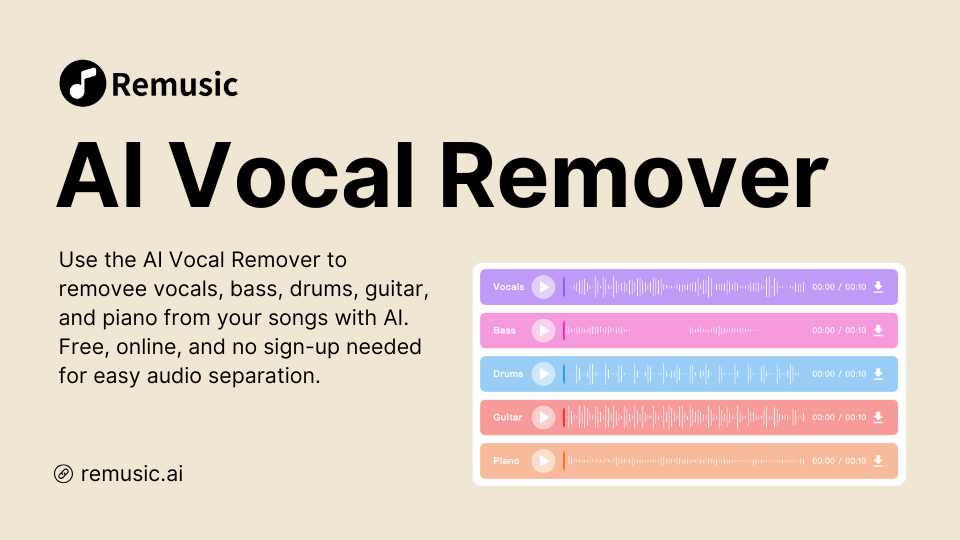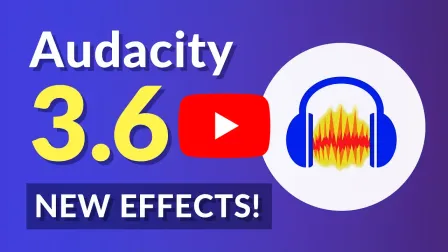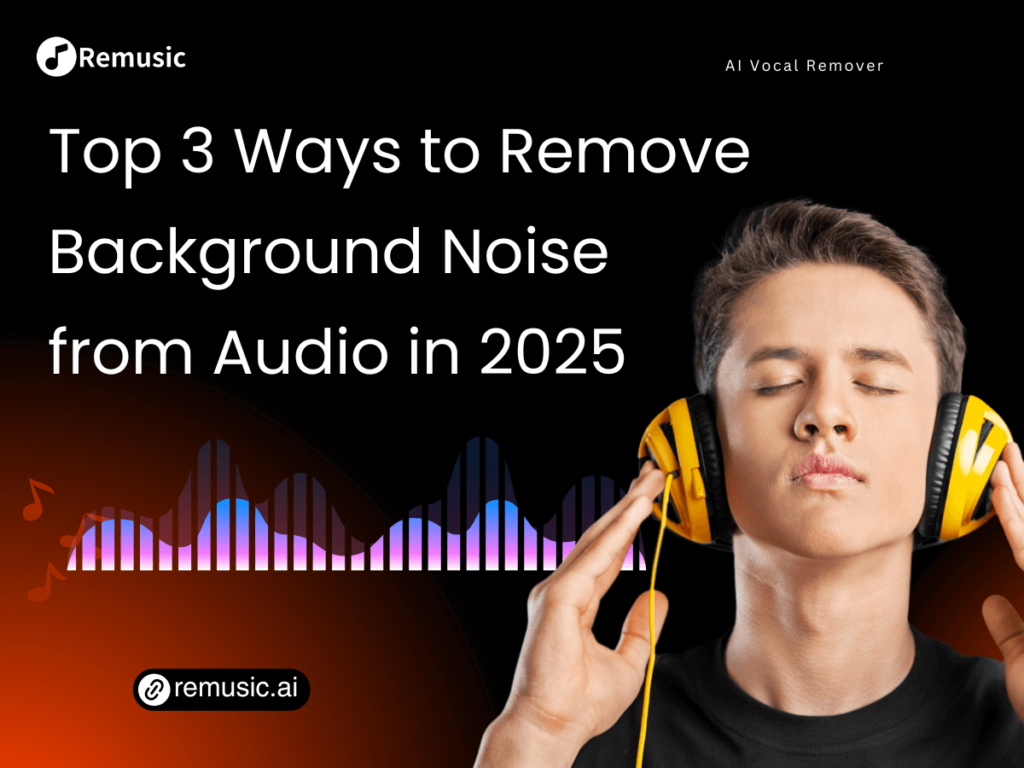Introduction: Why Remove Background Noise from Audio in 2025
Background noise has always been one of the biggest obstacles to professional-sounding audio. Whether you are recording a podcast, streaming live on YouTube, editing a film soundtrack, or just sending a voice message, unwanted sounds—like fan hum, keyboard clicks, static hiss, or outdoor traffic—can quickly reduce audio quality and distract your audience.

In 2025, audio cleanup has become much more accessible. Thanks to advances in AI, noise suppression is no longer reserved for professional engineers with expensive tools. Today, anyone can remove background noise from audio using AI-powered online platforms, classic editors and DAWs, or even in real-time during live sessions. This article walks you through the top three ways to remove background noise from audio in 2025—covering their strengths, weaknesses, and best use cases.
Top 3 Ways to Remove Background Noise from Audio
Way 1: Remove Background Noise from Audio with AI Tools
AI-powered tools are the fastest and easiest way to clean up audio in 2025. Many platforms now offer one-click background noise removal using machine learning models trained on millions of sound samples.

One notable example is Remusic, a platform originally known for its AI Vocal Remover. Beyond isolating vocals and instruments, Remusic has introduced a noise reduction feature that leverages similar deep-learning models. Instead of just separating voice from music, the system identifies unwanted noise patterns—like hissing, electrical hum, or room ambiance—and removes them while preserving speech clarity.
Remove Background Noise from Audio Now
When to Use AI Noise Removal
- Quick cleanup for podcasts, interviews, or voice notes
- Creators without audio engineering experience
- Users who need a clean track without fine-tuning settings
How It Works (General AI Workflow)

- Upload your audio file to the platform.
- The AI model detects and classifies unwanted noise.
- One-click removal processes the track within seconds.
- Download the cleaned version with significantly improved clarity.
Pros
- Extremely fast and user-friendly
- No technical skills required
- Cloud-based, works on most devices
Cons
- Less control over fine details
- May over-process in very complex recordings
This method is perfect for beginners, content creators, or anyone looking for speed and efficiency rather than technical depth.
Way 2: Remove Background Noise from Audio Using Editors/DAWs
If you need maximum control and don’t mind spending extra time, professional audio editors and DAWs (Digital Audio Workstations) remain essential. Software like Audacity, Adobe Audition, Logic Pro, or Reaper provide granular control over noise reduction.

How It Works (Example: Audacity)
- Select a segment of pure background noise (no speech).
- Capture a “noise profile.”
- Apply the noise reduction effect across the track.
- Adjust parameters like reduction strength, sensitivity, and smoothing.
Benefits of Editors/DAWs
- Control over every step of the process
- Ability to target specific frequencies
- Advanced editing features (EQ, compression, gating)
Downsides
- Steeper learning curve
- Requires manual fine-tuning
- Longer processing time
For musicians, sound designers, and podcasters who want precision, DAWs remain the most flexible solution. For example, Adobe Audition allows spectral editing, where you can literally “see” and erase noise visually. While slower than AI tools, this level of control is still unmatched.
Way 3: Remove Background Noise from Audio in Real Time
Another important option in 2025 is real-time noise suppression. Tools like Krisp, NVIDIA RTX Voice, or built-in Zoom/Google Meet noise controls can automatically filter background noise while you speak.
When to Use Real-Time Noise Suppression
- Online meetings and webinars
- Live streaming or gaming
- Virtual classrooms and presentations
These tools run in the background, analyzing your microphone input frame by frame. For instance, RTX Voice uses GPU-powered AI models to filter out everything except your voice—even if you’re in a coffee shop with heavy background chatter.
Real-time solutions are designed for convenience, ensuring your audience hears your voice without distractions, even if you’re in a noisy environment.
How to Choose the Best Method to Remove Background Noise from Audio
- AI Tools (Remusic, etc.) → Best for speed and simplicity.
- Editors/DAWs → Best for professionals who need precision.
- Real-Time Suppression → Best for live communication.
Think of it as a balance:
- Speed → AI
- Control → DAWs
- Live Use → Real-Time
If you’re unsure, start with AI and only move to DAWs if you need deeper editing.
Common Problems When You Remove Background Noise from Audio
Even the best tools sometimes cause artifacts. Here are common issues and fixes:
- Robot-like voices → Lower the intensity of noise reduction.
- Loss of natural ambiance → Use EQ or reverb to restore balance.
- Background noise still present → Combine noise removal with gating or EQ.
If you want to hear real-world demonstrations of these problems—and how professionals solve them—check out the Podcastage YouTube channel on audio recording and cleanup. It offers detailed mic tests, noise removal examples, and practical tips that can help you avoid common mistakes.
FAQs: Remove Background Noise from Audio

Q1: Can I remove background noise from audio for free? Yes. Free tools like Audacity and some AI platforms (including free tiers) allow basic noise removal.
Q2: What’s the easiest way to remove background noise from audio? In 2025, AI tools such as Remusic provide the fastest one-click solution.
Q3: Can I remove background noise from audio on my phone? Yes. Many mobile apps now include AI-based denoising, making it possible to clean audio directly on iOS and Android.
Q4: Does removing background noise reduce audio quality? Sometimes. Over-aggressive reduction may cause “tinny” or “robotic” voices. Using moderate settings usually prevents this.
Q5: How do I remove background noise in real-time? Apps like Krisp, NVIDIA Broadcast, and Zoom’s built-in noise suppression work instantly during calls or streams.
Q6: What if none of the tools work? In extreme cases, it may be easier to re-record in a quieter environment or invest in better microphones with directional pickup patterns.
Conclusion: The Future of Removing Background Noise from Audio
By 2025, creators no longer need to choose between complex workflows and poor-quality recordings. With AI-powered platforms like Remusic’s noise reduction tool, background noise can be removed in seconds. For users who want precision, traditional DAWs remain irreplaceable. And for anyone working live, real-time suppression ensures a distraction-free experience.
In short:
- AI for speed
- DAWs for control
- Real-time tools for live work
Whichever method you choose, the tools available in 2025 make it easier than ever to deliver clean, professional audio. And if you’re curious to see audio cleanup in action, don’t miss communities like Podcastage on YouTube, where real engineers test and demonstrate these techniques in practice.



